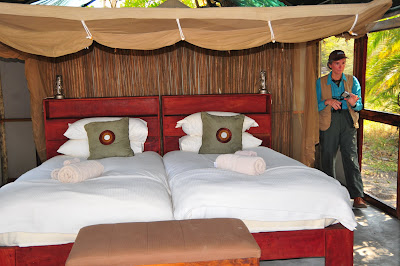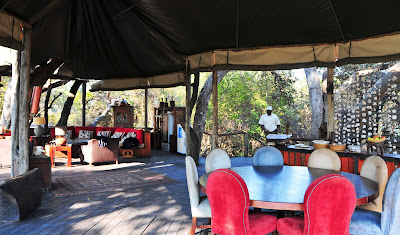Where most of us live – certainly here in
After yet another delightful brunch at Shumba, which included sautéed bream, a stuffed baked potato, fresh fruit salad, delicious green salad, as well as focaccia bread, we said our goodbyes and headed over to Busanga Bush Camp. BBC, as everyone refers to it, is a perfectly placed little camp, with just 4 tents, each of them with superb views over the floodplain. Compared with Shumba, it is on the ground (no walkways) and one feels truly connected to the environment. It is almost as if the Busanga Plains extends right to the front of your tent, and you are literally just a few steps from the wildlife environment. The tents are not huge but certainly big enough, with comfortable beds, a separate shower and toilet at the back of the tent, and a front porch where you can connect with

The setting for Busanga Bush Camp, on a small island in the Busanga Plains

Interior of one of the rooms at Busanga Bush Camp

The view from Tent # 4 - right on the plains. There are some trees not too far to the right, where the tree-climbing lions of the Busanga like to cool off in October

Part of the lounge and dining area at Busanga Bush Camp

The outdoor boma with bush chandelier, at Busanga Bush Camp

The lookout point at Busanga Bush Camp, with fantastic views over the plains

Busanga Bush Camp also has a very cozy outdoor fireplace
From BBC it is just a short drive to Kapinga, another very small camp (4 tents) in a superb setting on

The view from the pool at Kapinga Camp on the Kafue Plains

As seen from the deck

The dining room and lounge area at Kapinga Camp

A nice touch at Kapinga Camp


Bed oh bed, what a wonderful place to rest my weary head...

Interior view of part of the room at Kapinga

The view from our room

View over a portion of the deck area at Kapinga

Kapinga Camp has some magnificent trees around which the deck and common areas were constructed. At night a series of lanterns light up the area, making for a very romantic setting.
Our afternoon activity with guide Idos was specifically to see some Sitatunga, the rare and extremely shy antelope more commonly associated with the Okavango Delta than with
We were hardly there when he excitedly pointed out two Sitatunga standing in a small clearing on the edge of the massive papyrus thicket. We got a good look at them and then suddenly spotted several more; turned out there were 6 of them in total, including two young ones which were running around just like little impalas. Really an exceptional sighting, apparently the first time ever Idos had seen that many together in something like 16 years of guiding in the area. On the way back to camp we saw a family group of 6 water mongooses which Idos considered to be a unique sighting as these mammals are usually solitary. I also got some good photographs of Roan antelope so all in all it was a very successful afternoon outing.

Getting ready for brunch at Kapinga Camp

The papyrus grove where we saw 6 sitatunga at the same time

There was a sizeable herd of the rarely seen Roan antelope in the Kapinga area

A young Roan buck
August 10
Today was a relatively quiet and peaceful day, measured against the normal rather busy, action-packed day on safari. We were up at 0600 as usual, light breakfast at 0630 and then on a game drive by 0700 with Idos. The idea was to go and find some lions which had been heard calling earlier this morning, but no matter where we looked, they were not to be found. Eventually Idos saw some vultures circling and landing, and upon investigating we found the carcass of a dead animal; it turned out to be a cheetah kill from the previous night. Unfortunately we only found the kill, not the cheetah.

Lappetfaced Vultures are amongst the largest, most powerful off all vultures.

This white-backed vulture is trying hard to intimidate some of its competitors to get to the puku carcass below

Another white-backed vulture showing its impressive wingspan

One final shot of the vultures squabbling over the puku carcass
Then it was back to camp for brunch, followed by a nice long siesta and then a change of pace: we went walking for about 2 hours along the perimeter road, separating

The terrain through which we walked at Kapinga

On all walks inside the national parks a scout with rifle has to be present

Our guide Idos followed closely by Kathleen and our chopper pilot, Izak.

Idos talking about some animal tracks, estimating approximately when they were made

On walks it is possible to stop and study various plants and other organisms

The seed of the plant has the characteristic winged combretum form

A striking red flowering plant which turned out to be quite common

Sundowners in the bush, at the conclusion of our walking safari

A nice group of Lechwe in the Kapinga area
This evening Kathleen and I were treated to our first ever private dinner at our tent, with a small table and two chairs set up on the deck. Complete with several lanterns, a red tablecloth and napkins folded origami-style, it was quite the romantic evening. Just us, the stars and the opera of the bush: some frogs, an occasional bark like noise from a bush-buck in the thickets, and a Barred Owl making us aware of its presence. Dinner was delightful: a delicious tomato soup to start, main course of pasta with a pesto sauce and an apple crumble as the grand finale.
August 11
Another fairly quiet morning with Idos at Kapinga; despite his best efforts we could not find the cheetah responsible for the kill we saw yesterday. A bit later in the morning, we met up with a National Geographic film crew shooting a documentary – the Tree-climbing lions of the Busanga. Film maker Nathan showed us where the Busanga pride was holed up across the Lufupa channel. Even with binoculars we could just barely make out the difference between male and female, they were that far away. After getting up a few times, the lions appeared to settle in for the day, so we made our way back to camp to pack & get ready for the flight to the South Luangwa area.

Getting around the Busanga area involves crossing several makeshift 'bridges' such as this one, until very late in the season when the area finally dries out
 After being dropped off by chopper from Kapinga, we boarded a twin prop aircraft, our ride back to Lusaka
After being dropped off by chopper from Kapinga, we boarded a twin prop aircraft, our ride back to LusakaWe made a very tight connection in


No comments:
Post a Comment